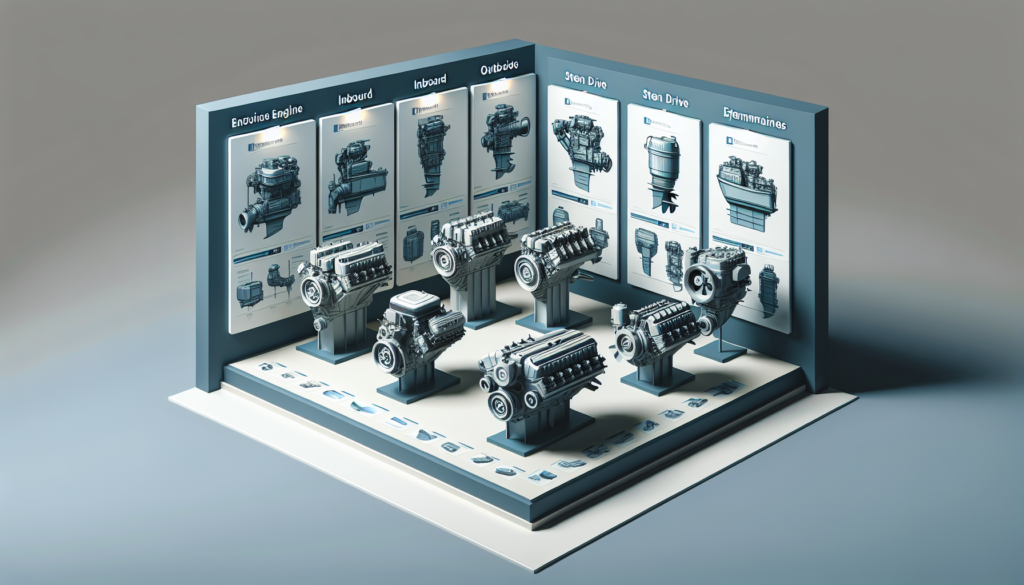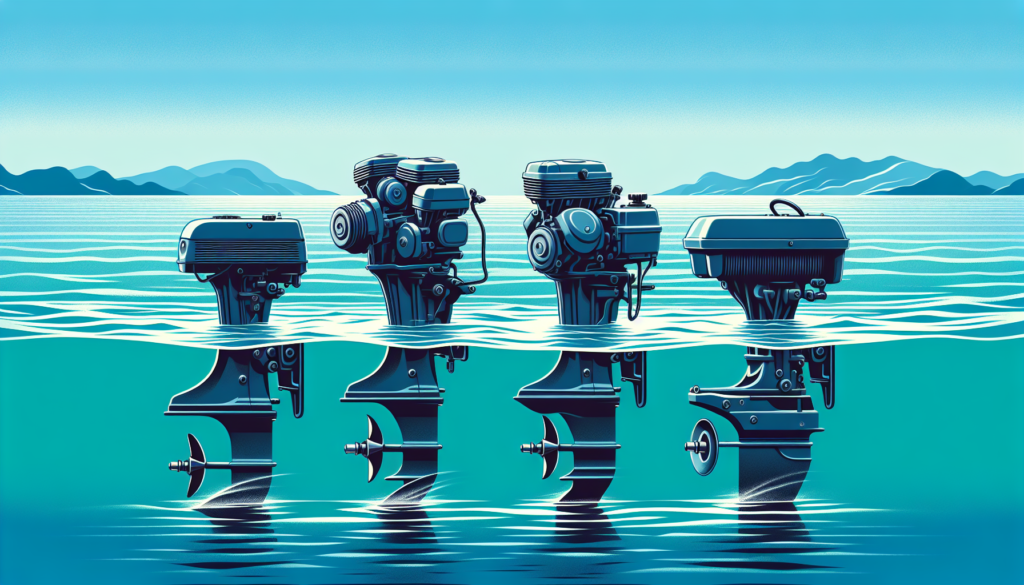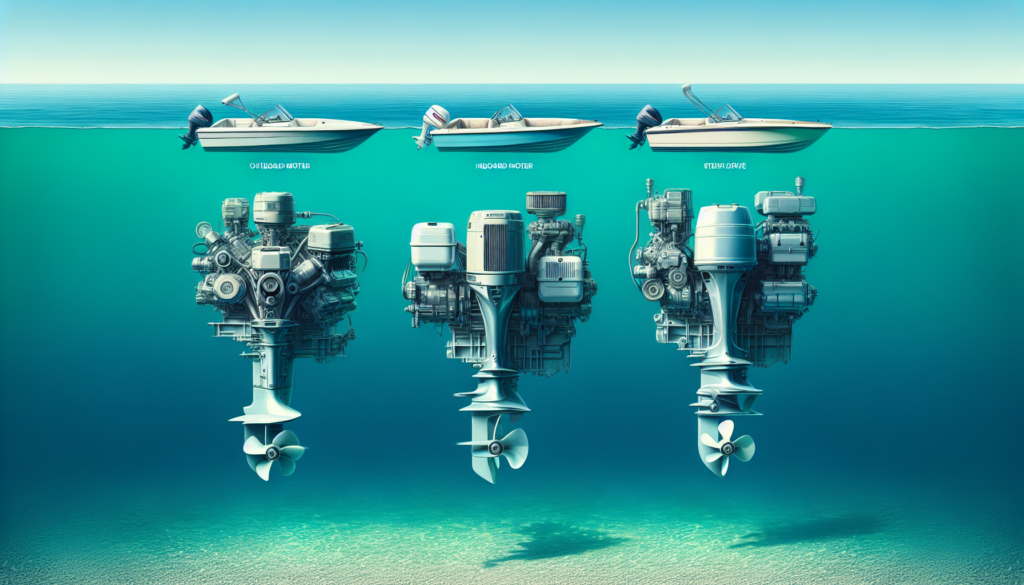So, you’re considering purchasing your first boat, but the vast world of marine engines has left you perplexed. This article, “Beginner’s Guide To Understanding Different Types Of Boat Engines,” could be just what you need to navigate through this confusing terrain. We’re going to simplify things by breaking down the key differences, details, and features of the most common boat engines available today. With this knowledge, you’ll feel confident in making an informed choice when your perfect boat comes along. Buckle up for a journey into the heart of marine mechanics.

Types of Boat Engines
When it comes to boating, understanding the mechanics behind the scenes is essential for a smooth sailing experience. One essential aspect you have to familiarize yourself with is the boat engine. There are four primary types of boat engines: the outboard, the inboard, the stern-drive, and the jet engines. Each type has its unique configuration, functions, and characteristics. Let’s delve deeper into each, shall we?
Outboard Engines
Outboard engines are the most common engines you’ll find on small pleasure boats. They’re portable, versatile, and efficient. Their compact design includes the engine, gearbox, and propeller in one unit that hangs over the back of your boat—a bit like a car’s bumper.
Inboard Engines
Unlike outboards, inboard engines are located inside the boat and are often seen in larger, more powerful boats. The engine is centrally fixed, and the drive shaft goes through the hull bottom to the propeller. This configuration leaves much more space on the aft deck of the boat.
Stern-Drive Engines
The stern-drive engines, often referred to as inboard-outboards (I/O engines) because they combine features from both types. They’re positioned inside the boat, like an inboard, but drive like an outboard. This versatile hybrid design results in a powerful and maneuverable engine.
Jet Engines
While less common than the other types, jet engines are worth knowing. They’re mostly found on personal watercraft, like jet skis. Instead of a propeller, they use an impeller (a rotating component) to draw water into a pump and then force it out at high pressure, creating thrust.
Understanding Outboard Engines
Let’s start dissecting some of these engines, beginning with outboard engines.
Components of Outboard Engines
The three basic components of an outboard engine are the engine itself, the propulsion system, and the steering system. The engine, whether two or four-stroke, generates the power, and the propulsion system (a set of gears and a propeller) provides the thrust. Meanwhile, the steering system, integrated into the engine’s mount, lets you control the direction.
How Outboard Engines Work
Here’s a basic rundown of how an outboard engine works. Combustion inside the engine generates power, which is then transferred through the drive shaft to the propeller at the lower unit. The spinning propeller creates a forward thrust, propelling your boat through the water. The trim and tilt system adjusts the engine angle for efficient operation, and you steer by simply turning the entire engine.
Advantages and Disadvantages of Outboard Engines
Outboard Engines are loved by many due to their simplicity and adaptability. They’re easy to operate, maintain and replace. They’re also self-draining, meaning you don’t have to worry about them freezing in colder weather. On the downside, outboard engines can be noisy and may not be the best fit for larger, high-speed boats due to their limited horsepower.
Maintaining Outboard Engines
Like any machine, outboard engines need consistent and proper maintenance to perform at their best. This often involves regular oil changes, spark plug replacements, and fuel system cleaning. Proper winterization is also vital if you’re in a colder climate.

Understanding Inboard Engines
Next up is inboard engines, the big brothers of the boat engine world.
Components of Inboard Engines
The key components of an inboard engine are similar to those in a car, including the engine, transmission, propeller, and rudder. The engine, located inside the boat, is connected via a drive shaft passing through the hull to the propeller. The rudder, separate from the propeller, is responsible for steering.
How Inboard Engines Work
In an inboard engine setup, the engine produces power, which is transferred to the propeller through a transmission and drive shaft. The spinning propeller creates a water flow that propels the boat forward. Unlike outboards, the direction is controlled by steering the rudder, not the propeller.
Advantages and Disadvantages of Inboard Engines
Inboards offer a smoother, quieter ride and often deliver more power than outboards, making them ideal for larger watercraft. They’re also positioned for better weight distribution and stability. However, they require more elaborate (and typically more expensive) maintenance and aren’t easily replaced due to their integration into the boat’s construction.
Maintaining Inboard Engines
To keep an inboard engine in top shape, you must adhere to a maintenance schedule that includes regular oil changes, filter replacements, fluid level checks, etc. Always check your cooling system, bilge area, and exhaust system for any signs of issues, as these are common trouble spots. Like outboards, proper winterization is also crucial.
Understanding Stern-Drive Engines
Now, let’s peek into the world of the best of both worlds – the stern-drive engines.
Components of Stern-Drive Engines
The stern-drive engine, also known as the Inboard/Outboard (IO), features an inboard engine connected to an outdrive (the outboard part) at the stern. This outdrive houses the drive shaft, propeller, and gearbox and is responsible for propulsion and steering.
How Stern-Drive Engines Work
In the stern-drive engine mechanism, the inboard engine produces power, which is then sent to the outdrive via the drive shaft, making the propeller spin. Much like outboards, the whole outdrive swivels to steer the boat.
Advantages and Disadvantages of Stern-Drive Engines
The biggest draw to stern-drives is their combination of inboard power with the maneuverability and ease of maintenance of outboards. They’re also tucked away none of the engine compartments, which means more space and a wider swim platform. However, they’re typically more expensive and not as fuel-efficient as outboards. They also require careful maintenance, as the combination of inboard and outboard components exposes them to both systems’ vulnerabilities.
Maintaining Stern-Drive Engines
For stern-drive engines, maintenance necessities include oil changes, belt, hose, and cable checks, along with propeller inspection and a vigilant eye on the cooling system. It’s particularly important to monitor the stern drive for any damages or leaks, as repair and replacements can be cost-intensive.

Understanding Jet Engines
Jet engines form a unique category of boat propulsion.
Components of Jet Engines
A jet engine comprises key components like the engine itself, an impeller (instead of a propeller), a water intake grate, and a steering nozzle. The engine mechanically drives the impeller, while the intake pulls in water, and the steering nozzle directs the water jet for acceleration and direction.
How Jet Engines Work
In jet propulsion, the impeller sucks in water through the intake grate and shoots it out in a high-pressure jet through the steering nozzle. This action creates a force that pushes the boat forward. To steer, the steering nozzle moves, vectoring the thrust in different directions.
Advantages and Disadvantages of Jet Engines
Jet engines are impeller-driven, meaning they’re safer for swimmers and marine life because there’s no external propeller. They’re powerful, responsive, and handle well at high speeds. Plus, their shallow draught allows them to navigate waters most other boats can’t. On the flip side, jet drives are often noisier, less fuel-efficient and require frequent maintenance due to the wear and tear on the impeller by the sand and small stones in the water.
Maintaining Jet Engines
Jet engine maintenance involves regular engine check-ups, oil changes, and impeller inspections. It’s critical to keep the water intake clear and ensure the water jet flow isn’t hindered for efficient propulsion.
Fuel Types for Boat Engines
Choosing the right fuel type for your boat engine is also a critical aspect of maintenance and performance.
Gasoline Engines
Gasoline engines are quite common in recreational boating. They’re often less expensive to install and easier to start in cold weather. You’ll commonly see them in outboards and stern-drives.
Diesel Engines
Diesel engines are usually found in larger boats. They offer better fuel efficiency and longevity. However, the initial cost is generally higher, and they require more diligent maintenance to prevent any issues from building up.
Electric Engines
While uncommon, electric boat engines do exist. They’re quiet, ecologically-friendly, and usually paired with solar panels or other alternative charging systems for long-term power. However, they can’t yet compete with petrol and diesel engines in terms of performance and range.

Understanding Gasoline Engines
Gasoline engines are popular for their ease of use and powerful operation.
Components of Gasoline Engines
A gasoline engine has several key components, including the engine block, pistons, cylinders, valves, crankshaft, spark plugs, and fuel delivery system. These components work together in a series of processes to generate power.
How Gasoline Engines Work
Gasoline engine operation involves four stages: intake, compression, combustion, and exhaust. In intake, the piston moves down, pulling gasoline and air mixture into the cylinder. Then, the piston moves up to compress this mixture, after which the spark plug ignites it, the explosion driving the piston back down. Finally, the piston moves up again to push out the exhaust gases.
Advantages and Disadvantages of Gasoline Engines
Gasoline engines are quite popular due to their lower initial cost and reliability. They’re lightweight, perfect for small to medium boats, and have a great power-to-weight ratio. However, they’re less fuel-efficient than diesel engines and tend to have a shorter lifespan. And, they need regular servicing for optimal performance.
Maintaining Gasoline Engines
Routine maintenance for gasoline engines includes oil and filter changes, general cleaning, fuel system checks, and spark plug inspection. Regular checks of the cooling systems, the alternator and the belts, and the drive system are also necessary.
Understanding Diesel Engines
Diesel engines are prominent in large boating applications due to their robust, reliable performance.
Components of Diesel Engines
Key components of a diesel engine include the engine block, pistons, cylinders, valves, crankshaft, fuel injectors, and turbocharger. They’re more robustly built than gasoline engines to withstand the high compression ratio of diesel fuel.
How Diesel Engines Work
The diesel production process involves four stages, too: intake, compression, combustion, and exhaust. In intake, air is sucked into the cylinders. Then, the pistons compress this air, which heats it significantly. The injectors then introduce diesel fuel, which ignites in the hot air, driving the pistons down. Finally, the pistons move up to expel the exhaust gases.
Advantages and Disadvantages of Diesel Engines
Diesel engines, recognized for their durability, offer excellent fuel efficiency and often have an extended lifespan. They are less likely to catch fire compared to gas engines because diesel fuel has a higher flash point. However, they’re more expensive up-front, both in terms of installation and maintenance.
Maintaining Diesel Engines
Diesel engine maintenance is crucial to their longevity. Common tasks include oil and filter changes, cleaning the injectors, checking and cleaning air filters, and maintaining the turbocharger. Regular inspection of major components for signs of wear and tear is also advisable.
Understanding Electric Engines
Advancements in technology have ushered in the era of electric boat engines.
Components of Electric Engines
An electric outboard motor is quite simple in terms of components. It usually consists of a battery, electric motor, propeller, control unit, and power inverter to manage the electrical output.
How Electric Engines Work
The electric boat engine operates by converting electrical energy into mechanical energy. When the battery supplies power, the motor uses this to rotate the propeller, moving the boat forward.
Advantages and Disadvantages of Electric Engines
Electric boat motors are entirely emission-free, quiet, and require significantly less maintenance than their gasoline or diesel counterparts. This makes them great for the environment and suitable for calm waters like lakes and canals. However, they require long charging times, and the range isn’t as extensive. The overall performance and speed also may not match up to their combustion counterparts.
Maintaining Electric Engines
Maintaining electric engines mainly involves looking after the battery. Regular charging, keeping it clean, protecting it from extreme weather conditions are among the top priorities. Besides, a regular inspection of the motor and propeller for any sign of wear, corrosion or other damage is advised.
Understanding Boat Engine Maintenance
Maintaining your boat engine is crucial for prolonging its lifespan and ensuring smooth sailing adventures.
General Maintenance Tips
Regular oil changes are a must for all types of boat engines. Keeping your engine clean might seem trivial, but it’s important for detecting any leaks, corrosion, loose parts, etc. Remember to check the cooling system, the fuel system, and the electrical system regularly. Regular inspection and maintenance of the drive system, be it the propeller, drive shaft or impeller, is also crucial.
Common Engine Problems and Troubleshooting
Boat engine problems can range from simple to complex. Some common issues include difficulties in starting the engine, engine overheating, erratic engine performance, and increased fuel consumption. Thorough troubleshooting involves checking the fuel supply, the ignition system, and the cooling system. Consulting your boat engine manual or a professional mechanic can help you address these issues.
Resources for Learning More about Maintenance
There are tonnes of resources out there to help you master boat engine maintenance. These include engine operational manuals, professional boating courses, instructional DVDs, and comprehensive boating guides. You can also find boat engine forums and blogs online that offer practical tips and tricks from experienced boaters.
In conclusion, your boat engine’s health and performance lie heavily in your understanding of it and how well you keep it maintained. With some basic knowledge, you can prevent potential problems, solve minor ones, and make informed decisions on bigger issues, leading to many happy hours on the water.


